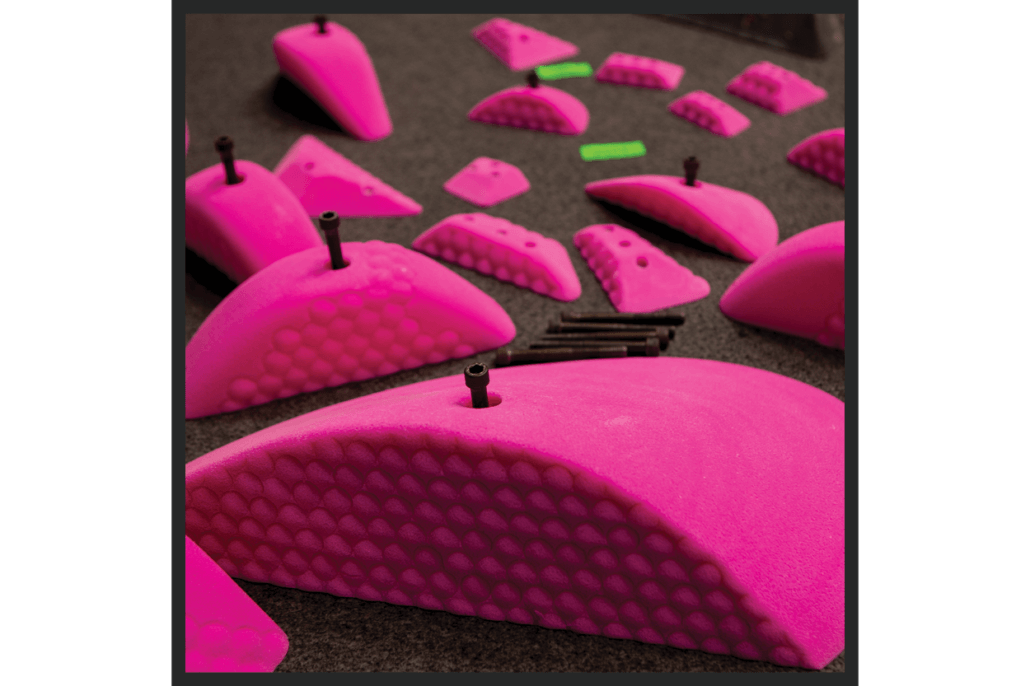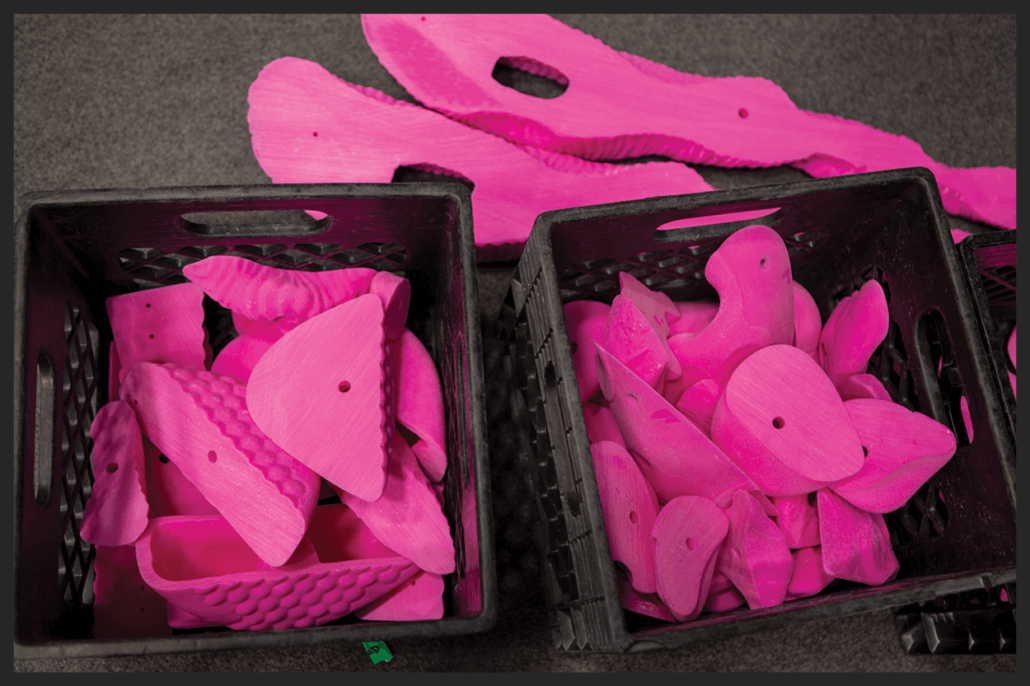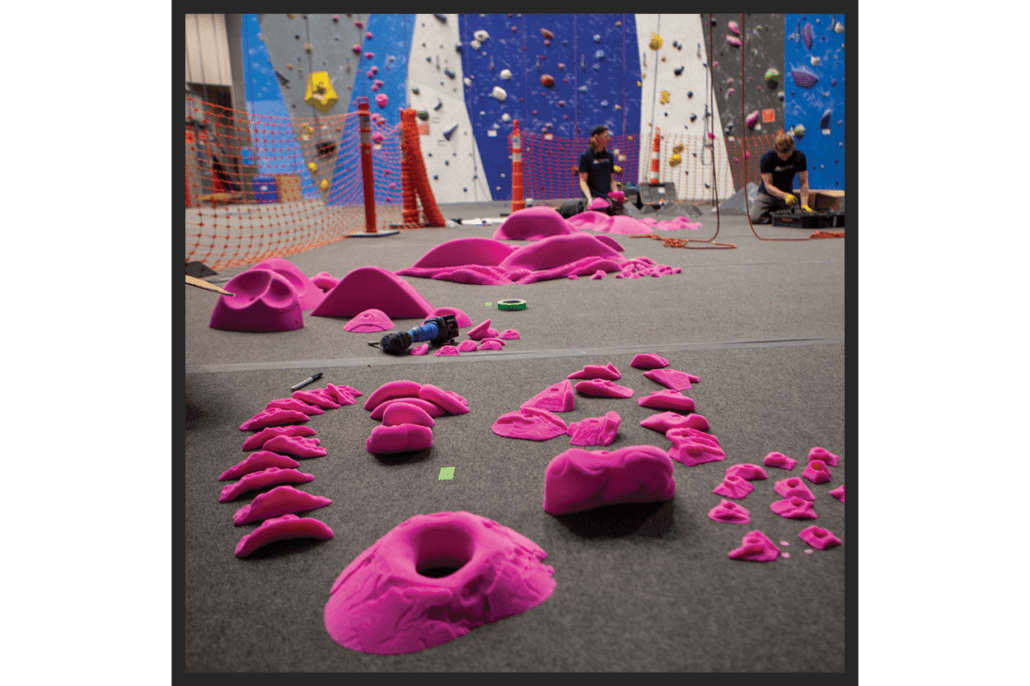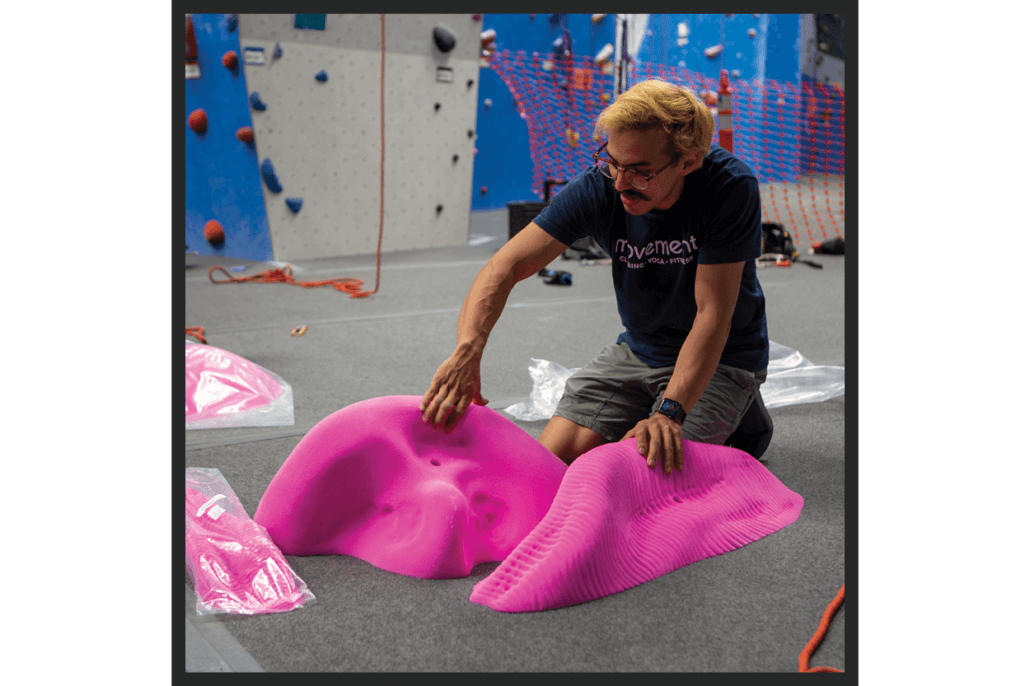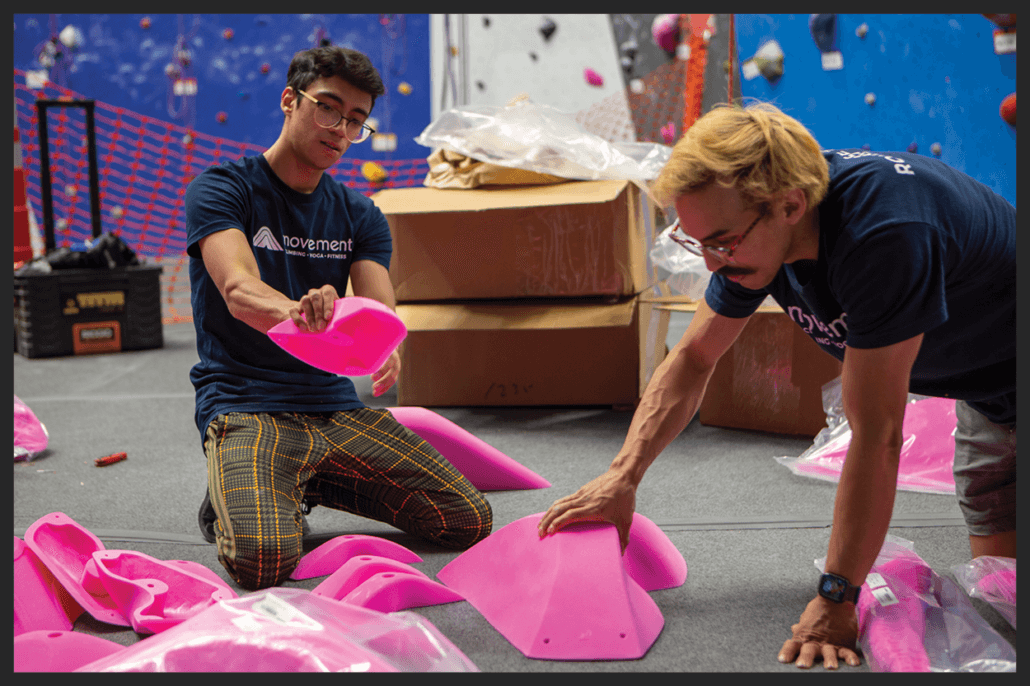From L – R: Matt Bosley, Charley Van Anda, Ward Byrum, Matthew Vesely, Chris Canela, Sammy Vasquez
For our first feature in the Setter Spotlight series, we went to visit Movement’s Crystal City location in Arlington, VA. The lead routesetters from all five of Movement’s locations in the DMV gathered to collaborate and set together as a team. The routesetters brought high energy and excitement with them, as they rarely get an opportunity to work together on a project of this scale. At the end of the day, they’d put up a long, eye-catching route that ascended the lead cave, filled with interesting movement and increasing in difficulty as the climb progressed.
Meet the Setters
Ward Byrum
Director of Routesetting – VA/MD/IL/TX
Matthew Vesely
Head Routesetter – Movement Columbia
Matt Bosley
Head Routesetter – Movement Timonium
Chris Canela
Assistant Director of Routesetting – Movement Crystal City
Sammy Vasquez
Head Routesetter – Movement Rockville
Charley Van Anda
Assistant Director of Routesetting – Movement Hampden
The Holds
For their route, the team was given their choice of any holds in our catalogue. They settled on a selection of holds from some of our most iconic styles since the inception of Trango Holds. Routesetters and climbers alike will recognize styles like Bubble Wrap and Mammoth Rub on the walls of gyms around the globe. The vision was to reflect the evolution of Trango Holds on the wall, with our earliest shapes flowing into our newest.
Bubble Wrap
Bubble Wrap Big Wave
Bubble Wrap Big Pinches
Bubble Wrap Flat Screw-Ons
Main Dish
Dish Power Pinch
Dish Dream Pockets
Myorcan Double Tufa Pinch
Myorcan Knubs
Myorcan Tufa Big Wave
Giant GeoFin
SoCo Sleeping Giant
Stealth 2Tex Shelf
Stealth 2Tex Slopers
Khan Mega Sloper Jug
Khan Crimps
Khan Sloper Jugs
eGrips Classic Home Gym Kit
The Route
Set prominently in the lead cave, the route is easily seen as one enters the roped climbing area. The route began on slightly overhanging terrain, eventually moving into a fully horizontal roof filled with large holds and volumes, demanding creative movement from the climber. Moving onto the head wall, the climber is faced with larger holds and larger moves leading up to the anchors. Winding its way up the wall, the route is about as long as it could be, requiring a great deal of endurance to complete. Looking at the entire route, it’s easy to see the evolution of trends in climbing holds from the early days with holds resembling more natural rock features to more abstract and artistic shapes of modern times.
Setting a route can be a challenging task for one routesetter, let alone six. A long 8-hour day began with dividing up the holds based on release year and divvying them up between all the setters. They used a white board to sketch out the wall and their rough vision for the route. Then, the setting began.
Matt, who has been setting with Movement Gyms for __ years, set the start of the route, using some of Trango’s most classic holds from the 90s and early 2000s: Granite Ledges, Papa Elephant, Hueco Wonder Hole, and Comfy Crimps.
From there, Ward took over with a pair of Main Dishes, the Dish Power Pinch, Dish Dream Pockets, and Drop Art Finger Buckets. The route begins to move into more overhanging terrain, with an opportunity for a kneebar rest between two large dish holds before pushing through the roof.
Matthew was up next, bringing a massive volume and the iconic Bubble Wrap style onto the wall. He impressively wrestled to secure the pyramid-shaped volume onto the 45-degree overhang wall, and placed the Bubble Wrap, Bubble Wrap Big Wave, Bubble Wrap Big Pinches, and Bubble Wrap Ledges on two of its faces, making for fun and creative movement.
At this point we’ve reached the pure horizontal roof. Charlie set his sequence through this challenging terrain with the massive Myorcan Tufu Big Wave, the Myorcan Double TufaPinch, Myorcan Tufas, and Myorcan Knubs. To close out his section, he set the SoCo Sleeping Giant on one side of a volume, the last hold as the climber moves out of the roof and onto the head wall. This large, bulbous hold could be approached and scaled in a number of ways, making for a thoughtful moment in the route.
Moving onto the head wall, climbers meet the Giant Geo Fin, which leads to a section of Stealth 2Tex Slopers flanking a giant Stealth 2Tex Shelf set by Chris. With sparse footholds and directional pulls, this section increases in difficulty as the end of the route nears. The slick 2Tex finish on the holds requires precision from the climber, a contrast to the middle section of the route, where multiple approaches to movement are equally successful.
Sammy, the most recent addition to the Movement setting team, closes out the climb with a challenging section through Khans Sloper Jugs, Khans Crimps, and two large Khans Mega Sloper Jugs. As a finishing touch, Trango icon stickers were placed above each quickdraw to help guide climbers to the anchors.
The crew didn’t target a specific grade when setting, but rather wanted to set something that would be approachable to many climbers who are comfortable in the lead cave. The end result was a route that progressed in difficulty from start to finish, with the opening sequence close to 5.10+, and the final section coming in around 5.12-. After forerunning and making small tweaks, both Sammy and Matt hopped on the climb for its first runs.
SETTING
FINAL SEND: MATT
FINAL SEND: SAMMY
Setter Q&A
We chatted with the setters to learn about their backgrounds, how they approach setting, their preferred styles of climbing, and what it was like working with each other on this project.
What’s your experience and background with routesetting?
Charley: I have been setting on and off since ~2005. I am currently the Assistant Director of Setting for Movement – Baltimore District.
Chris: I’ve been setting for around 6 years, mostly commercial. I’ve dabbled in a few comps, but that life just isn’t for me. My setting style leans towards more powerful and pinchy (big fan of the new Calientes).
Matt: I started climbing about 27 years ago. I have been routesetting for about 20 of those years.
Matthew: Currently I am the Head Setter of Movement Columbia, my entire routesetting career has been with the company, working various roles since 2013. I started by assisting the setting department in any way possible, whether it was washing holds, reinstalling T-nuts, or sorting bolts and screws. I worked as a full time routesetter in the Timonium location for 2 years before moving to Columbia, where I’ve resided for 5 years now.
Sammy: My background with routesetting came from being around the gym, hanging out, and interacting with everyone that worked there from a young age. As I got older, it piqued my interest as to how you can come up with ideas for people to climb and I thought to give it a try and put some climbs for people to try and experience moves that I have come across from my climbing experience. From there on I continued to practice, make some adjustments to my setting, getting me to where I’m at now.
Ward: I found climbing in the mid-90s and began setting pretty soon after that. My art and design background combined with my passion for climbing has created the foundation I’ve built a 25-year career on.
Were there any challenges you ran into when you first started routesetting?
Charley: One of the biggest challenges in setting is creating a fun equitable experience. Through the years I am learning more and more how to make climbs enjoyable for all users regardless of age or body type.
Chris: I think the biggest challenge has been putting aside my ego and accepting feedback from members, friends, and other setters and respecting their perspective. It’s incredibly valuable to see people “beta break” a climb and ask why they didn’t feel encouraged to execute my intended sequence. I find these conversations lead to very good learning moments as a setter and it’s important to create that connection.
Matt: Haha…. Even though I was a semi-experienced climber when I began routesetting, it was difficult to translate all the movement ideas that I had to the wall. Overtime that got easier.
Matthew: My biggest challenge early on was creating a product efficiently. I saw my coworkers putting 3-4 routes up a day while I was struggling to put up 1 route. I quickly learned to create 1-2 special moments, while focusing on flow between those points. This resulted in less forced movement and efficiency while setting.
Sammy: Definitely some of the challenges that I always face with routesetting is the initial thought as a whole. Oh I have this great idea for a certain move and I’m able to see it clearly in my head, and once I put it on the wall it becomes the opposite of what I intended to do. I try not to bash my head into it and make it work, and just see the bright side of what’s the actual move that I sent rather than the intention of it. Just adapting to it and not forcing it. Those are the main challenges that I always face when setting. The initial thought, and then adapting. Let’s say I’m setting for a comp and I have an idea that I want to put on the wall, and then I’m on it and it’s not what I was intending, so instead of wasting time trying to fix it, I just scrap it, or adapt.
Ward: In general, the challenge is creating and pushing the limits while maintaining empathy for the consumer. Finding the right dosage of challenge, lesson, exploration, and success for each gym user.
How do you approach setting a route? Do you start with ideas for specific movement or skills?
Chris: Some days I come in with a specific idea, and I’ve planned materials around that idea. Other days I have no plan, and I look in the holds bin and see that I have a nice crimp line ready to go for me, or a nice little 4-move pinch boulder. It’s important to adapt to your resources as opposed to just bashing your idea on the wall, because I think you’ll have a lot more success if you let the wall and the holds help you set, as opposed to you putting your idea on there. I think a lot of people get a vision for a specific move, and it’s like, well first, you need to have the right terrain, you need to have the right holds, you need to know when the space is allowing you to do that, and sometimes it just can’t happen.
Matt: First, I assess the terrain- slab, vert, steep, etc. Next, I pick grips that will work on those wall angles at the grade level that I’m looking to set. I also try to pick the nicest holds/volumes that are available that day. The better the hold selection, the easier it is to set interesting fun routes that are also visually appealing. Within that, I do try to balance the use of features and larger holds throughout the route.
Matthew: With commercial setting, I generally let the wall angles and hold resources dictate the climb. If there is an arete or dihedral, I try to play into those features. I look for overall fun, comfortability of the movement, and equitable body positions, while avoiding injury-prone moves.
Sammy: I approach setting like building a puzzle that isn’t built yet. I don’t know how or where to start, but I got to start somewhere and figure it out as the route/boulder gets built. At the end we have a fun little puzzle for climbers to enjoy and figure out.
Ward: I like to use a variety of approaches, inspiration points, and techniques. This helps to keep the process and results fresh and motivating to both me (as the creator) as well as the climber (as the end user).
How do you account for different body types/sizes and skill levels?
Charley: We have multiple forerunners of varying body types to “test” out the climbs as we set them. Also, directional holds, bump holds, and multiple foot options help out.
Chris: I always like to think about the average height as my muse, sort of. I think the average height for a woman is around 5’4” and for a man it’s around 5’9”, so I like to think about the 5’5”, 5’6” range. Taller climbers can always get slightly higher feet, but shorter climbers can’t always use feet that are super low, so taking into account and understanding that maybe the foot is a little low and we can just raise it up to make a high foot moment for a taller climber, but it’s the pe


